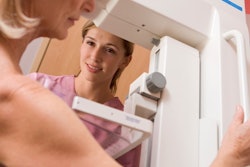
Women have particular preferences for how they receive medical care -- even down to their selection of a breast imaging center, according to a study published online June 28 in the American Journal of Roentgenology.
What factors are most influential? Where the facility is located and whether its radiologists have breast imaging training, found a team led by Dr. Rajni Natesan of MD Anderson Cancer Center.
"Our study revealed that patient preferences for breast imaging care -- specifically regarding imaging center location and radiologist training -- exist across demographic groups and that these preferences may influence the way women choose a breast imaging center," the authors wrote.
Location, location, location
Although previous research has examined how patients select healthcare plans, hospitals, primary care physicians, and specialist providers, there hasn't been much investigation of the factors and demographics that shape patients' choices regarding breast care, according to Natesan and colleagues.
"Studies show that healthcare tailored to patient preferences results in significant improvements in physician performance, patient satisfaction, and health outcomes," they wrote. However, "limited information in the literature exists on the factors driving patient preferences for establishing care at specific breast imaging centers."
For the study, the researchers used an 18-question survey that collected information on patient demographics and preferences (using a rating scale from 1 to 10, with 1 being the level of least influence and 10 being the most). In particular, they tracked factors such as location, reason for visit, age, education, marital status, ethnicity, insurance, history of cancer, and income. The team administered the survey between August and September 2015 at an academic center and private hospital sites.
Natesan and colleagues received 1,682 responses, 667 from the academic center and 1,005 from the private hospital sites (10 participants did not provide location information). Reasons for visiting the imaging center included annual screening mammography (78.3%), additional imaging for evaluation of abnormal mammography findings (18.2%), and diagnosis and treatment of breast cancer (2.5%). Only 1.3% of survey participants' reasons for visiting the center were unknown.
The patients fell into six main groups, although the researchers included only the first four in their analysis. (Group 5 respondents were "naysayers," with uniformly low numeric preference numbers; group 6 respondents felt the factors behind breast center choice such as location or radiologist training made no difference.) Across the four groups, there were no significant differences in age, marital status, insurance, and income.
The four analyzed groups of survey participants included the following:
- Those primarily interested in convenience (12.4%): These respondents showed a preference for locations apart from medical centers across all scenarios of care, regardless of radiologist training in breast imaging.
- Those ambivalent about location and radiologist training (27.1%): These respondents showed greater variability in preferences regarding imaging location and additional radiologist training.
- Those interested in a medical center location (37%): These patients favored a medical center for breast imaging across all scenarios of care.
- Those interested in radiologist expertise (23.5%): These survey participants had a strong preference for radiologists with additional breast imaging training, regardless of location.
There were some demographic differences among the cohorts, however. The researchers found significant differences in education level across the groups, with college-educated respondents generally more interested in medical center care and radiologists trained in breast imaging. The team also found that "expertise seekers" had the highest percentage of respondents who were white, while "convenience optimizers" had the highest percentage of black respondents. Those who sought a medical center location had a greater personal history of breast cancer than did those who sought convenience or who were ambivalent.
Into action
How might the study findings translate into patient care? As one example, Natesan and colleagues suggested that a facility could offer a variety of locations to its care population so that "convenience optimizers" are provided with nearby community locations for breast imaging, as well as the medical center option.
Understanding women's preferences regarding breast health translates into better care, according to the study authors.
"With sensitivity to the distinct needs and preferences of patient subpopulations, institutions can provide service and expand in meaningful ways to positively impact early detection of breast cancer and outcomes," they concluded.



















